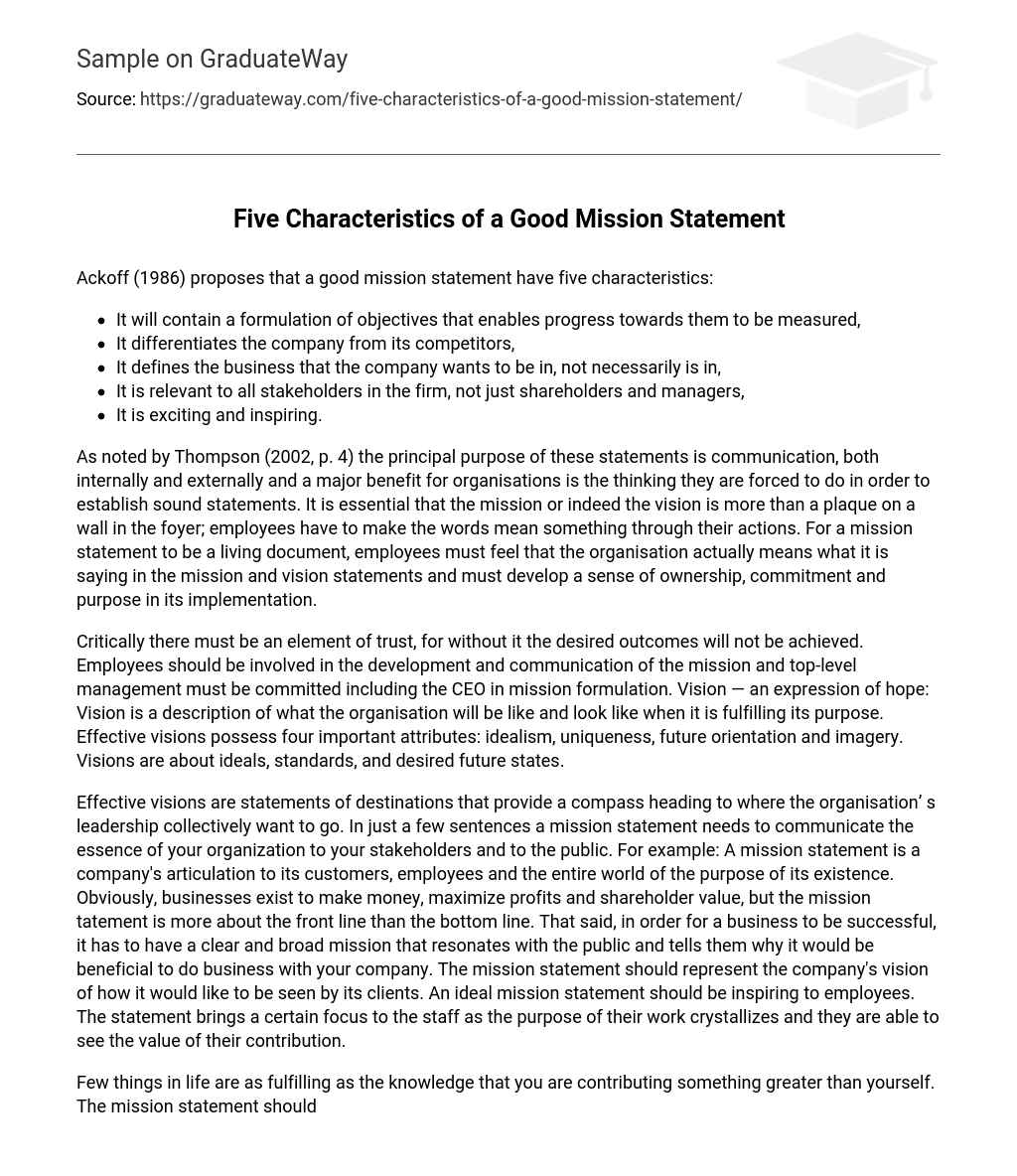Ackoff (1986) proposes that a good mission statement have five characteristics:
- It will contain a formulation of objectives that enables progress towards them to be measured,
- It differentiates the company from its competitors,
- It defines the business that the company wants to be in, not necessarily is in,
- It is relevant to all stakeholders in the firm, not just shareholders and managers,
- It is exciting and inspiring.
As noted by Thompson (2002, p. 4) the principal purpose of these statements is communication, both internally and externally and a major benefit for organisations is the thinking they are forced to do in order to establish sound statements. It is essential that the mission or indeed the vision is more than a plaque on a wall in the foyer; employees have to make the words mean something through their actions. For a mission statement to be a living document, employees must feel that the organisation actually means what it is saying in the mission and vision statements and must develop a sense of ownership, commitment and purpose in its implementation.
Critically there must be an element of trust, for without it the desired outcomes will not be achieved. Employees should be involved in the development and communication of the mission and top-level management must be committed including the CEO in mission formulation. Vision — an expression of hope: Vision is a description of what the organisation will be like and look like when it is fulfilling its purpose. Effective visions possess four important attributes: idealism, uniqueness, future orientation and imagery. Visions are about ideals, standards, and desired future states.
Effective visions are statements of destinations that provide a compass heading to where the organisation’ s leadership collectively want to go. In just a few sentences a mission statement needs to communicate the essence of your organization to your stakeholders and to the public. For example: A mission statement is a company’s articulation to its customers, employees and the entire world of the purpose of its existence. Obviously, businesses exist to make money, maximize profits and shareholder value, but the mission tatement is more about the front line than the bottom line. That said, in order for a business to be successful, it has to have a clear and broad mission that resonates with the public and tells them why it would be beneficial to do business with your company. The mission statement should represent the company’s vision of how it would like to be seen by its clients. An ideal mission statement should be inspiring to employees. The statement brings a certain focus to the staff as the purpose of their work crystallizes and they are able to see the value of their contribution.
Few things in life are as fulfilling as the knowledge that you are contributing something greater than yourself. The mission statement should allow each employee to see their own personal role in the firm’s success. Customers will be reassured when they are exposed to the statement as they will be able to see that the company is committed to their purpose. Customers can also sometimes form a connection with the firm if the values outlined are ones they share. People like to work with others that they like and agree with, it’s a natural human instinct.
If you are looking for a pointless waste of time to spend a few committee meetings on, I’d suggest taking up the task of writing a mission statement. Writing mission statements is one of those tasks that people argue is a good idea because it will help us to build consensus on what our collective purpose is, to better understand where we are going as an organization, and to guide decision-making as we move forward. * The truth is, mission statements rarely do any of that. I was recently in a meeting with a development consultant who was a real pro.
He pointed out, correctly, that no one in the room could recite or even summarize what was in our own mission statement. If people don’t even know what’s in the mission statement, it can hardly accomplish any of those aims. On top of that, mission statements, especially when they are written by committee, are so broad, meandering, and/or vacuous, that they don’t say anything, can barely be understood, and thus can hard be expected to guide anything. I recently found out that a certain unit on our campus requires each ommittee in its unit to write a mission statement! I was flabbergasted. If this is what is considered an effective use of time, I can hardly imagine how anyone in that unit has time to accomplish any of their key responsibilities. “The mission of Wendy’s is to deliver superior quality products and services for our customers and communities through leadership, innovation, and partnerships. ” Don’t get me wrong. I love Wendy’s, but I’ve never thought I was participating in “leadership, innovation, and partnerships” when I ordered a hamburger there.





